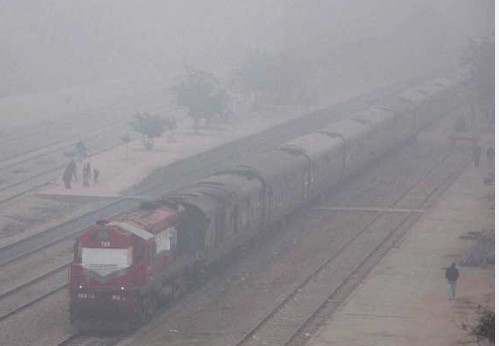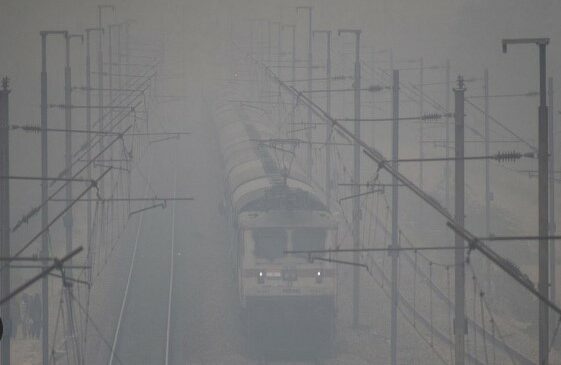
Delhi-NCR Fog Causes Delay: 14 Trains Affected by Low Visibility
Delhi-NCR fog Results in Train Disruptions: Low Visibility Affects 14 Trains
The Northern Railways has reported that 14 trains in the northern zone are currently facing disruptions due to dense fog in the national capital on Tuesday. As of today, a statement from the Chief Public Relations Officer indicates that 14 trains are affected due to fog or reduced visibility in the Northern Zone of Indian Railways.
The delayed arrivals in Delhi include the Puri-New-Delhi Purushottam Express, Howrah-New-Delhi Poorva Express, Kanpur-New Delhi Shramshakti, Allahabad-New-Delhi Prayagraj, Azamgarh-Delhi Kaifiyat Express, Bhagalpur-Anand Vihar Vikramshilla, Gaya-New Delhi Magadh Express, Dibrugarh-New Delhi Rajdhani, Durg-Nizamuddin Samparkkranti, Chennai-New Delhi GT Express, Hyderabad-New-Delhi Telangana, Habibgang-New-Delhi Bhopal Express, Khajuraho-Kurukshetra Express, and Vasco-Nizamuddin Goa Express.
Based on data from the Airport Flight Information Display System, approximately 30 flights, including international ones, faced delays in both arrivals and departures earlier in the day due to dense fog. Airport officials indicated the possibility of flight diversions due to low visibility.
As of the latest information, five flights were diverted to Jaipur between 8:30 a.m. and 10:00 a.m. due to adverse weather conditions at airport. A passenger advisory was issued by the airport for the second consecutive day, informing travelers that while landings and takeoffs continue, flights not compliant with CAT III standards might be affected. The advisory urged passengers to contact their respective airlines for updated flight information.
CAT-III Instrument Landing System (ILS) is an anti-fog landing system implemented by airport authorities to aid landings in low visibility conditions.
A persistent “very dense” fog enveloped Delhi for the second consecutive day, reducing visibility to 50 meters in certain areas. This atmospheric condition disrupted air and rail operations, causing the diversion of five flights to Jaipur and delays for over 25 flights and 14 trains. The air quality remained in the very poor category, with the mercury dropping to 7°C.
The Delhi Airport reported that despite the challenging conditions, landings and takeoffs continued. However, flights lacking equipment for low-visibility landings may experience disruptions. The northern railways reported at least 14 trains running late by over an hour until 9:30 a.m. The affected trains included the Puri-New-Delhi Purushottam Express, the Gaya to New Delhi Magadh Express, the Howrah-New-Delhi Poorvah Express, and the Chennai-New-Delhi GT Express. Train speeds were reduced for safety reasons during foggy conditions.
According to the India Meteorological Department, visibility significantly deteriorated overnight, reaching 50 meters at around 8 a.m. The fog caused traffic congestion at the Capital’s borders on Monday morning, and zero-meter visibility at Indira Gandhi International Airport prompted the diversion of seven flights to Jaipur and one to Ahmedabad.
The recorded minimum temperature on Tuesday was 7°C, a degree below normal, while the maximum temperature on Monday was 23.8°C, expected to remain around 24°C on Tuesday.

Warmer daytime temperatures have been linked to the El Nino weather phenomenon, according to experts.
At 9 a.m., an average Air Quality Index (AQI) of 374, categorizing it as “very poor,” marked a slight improvement from the Monday 4 p.m. reading of 383 (also “very poor”).
Although the AQI moved out of the severe zone after a three-day stint, it remained significantly above safe limits on Monday.
A forecast indicated the expectation of “dense to very dense” fog enveloping Delhi and extensive parts of northwestern India until Wednesday. Rainfall was anticipated on both New Year’s Eve and New Year’s Day.
The prevailing warmer daytime temperatures, attributed to the El Nino weather phenomenon by experts, continue to impact the weather dynamics in the region.
As of 9 a.m., the Air Quality Index (AQI) showed a marginal improvement, recording an average of 374, categorizing the air quality as “very poor.” This represents a slight positive shift from the 4 p.m. reading on Monday, which stood at 383, also falling under the “very poor” category.
While there is a noticeable improvement as the AQI moved out of the severe zone after a three-day period, it remains significantly elevated, surpassing safe limits on Monday. The persistent concerns over air quality underscore the ongoing challenges faced by the region in maintaining a healthy and sustainable environment.
Looking ahead, a “dense to very dense” fog is expected to shroud city and large portions of northwestern India until Wednesday. Additionally, the anticipation of rain on both New Year’s Eve and New Year’s Day brings a mix of weather conditions, offering potential relief and posing challenges for residents and travelers alike.
The convergence of these weather patterns emphasizes the need for continued vigilance and adaptive measures to address the environmental impact and potential health implications associated with fluctuations in air quality and weather conditions in the region. As the public navigates through these weather variations, staying informed and adhering to recommended safety measures becomes crucial for the well-being of the community.
For the latest updates-click here.


